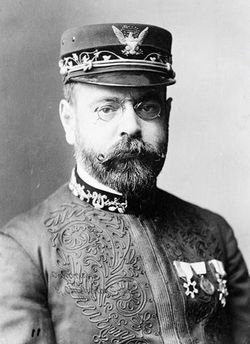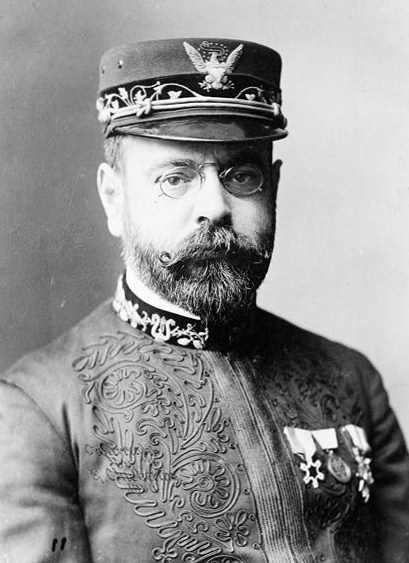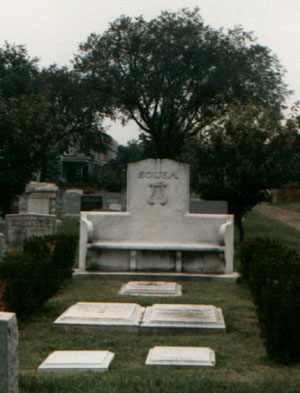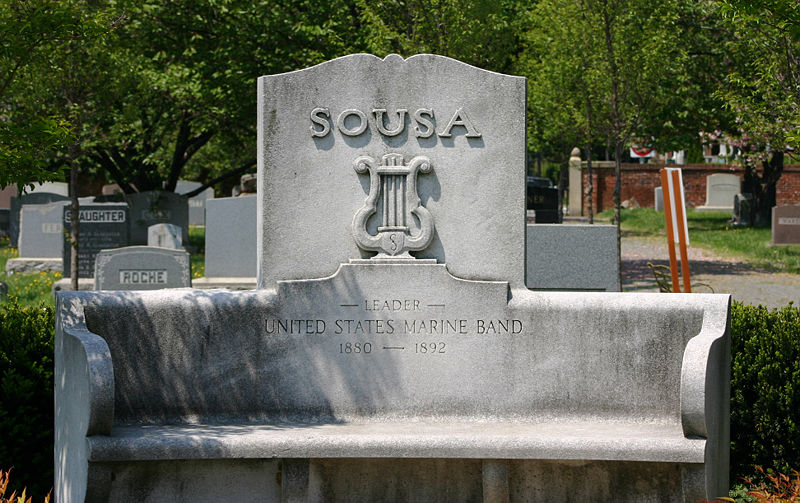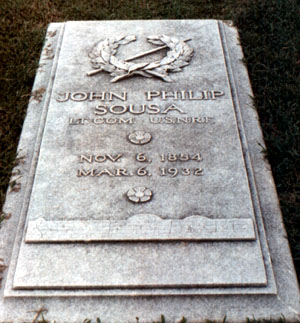The greatest of his more than 100 marches is "The Stars and Stripes Forever" (1896). It was named the National March of the United States by an Act of Congress, and still provides the musical climax of many Independence Day celebrations. His other well-known marches include "Semper Fidelis" (1888), the official march of the United States Marine Corps; "The Washington Post" (1889), the popularity of which led a British newspaper to first dub Sousa "The March King;" "The Thunderer" (1889); "The Liberty Bell" (1893), later famous as the theme music for the comedy group "Monty Python's Flying Circus;" "El Capitan" (1896); and "Hands Across the Sea" (1899).
Sousa was born in Washington, D.C. After studying violin and harmony, he began his professional career at 17 performing in theatre and dance orchestras. From 1876 to 1877, he played in the orchestra of Jacques Offenbach when the famous French composer toured America, an experience that left a profound impression on him. Sousa became one of the first American composers of operetta, beginning with "The Smugglers" (1882) and culminating with the hit "El Capitan" (1896).
From 1880 to 1892 he headed the United States Marine Band, then formed the Sousa Band and went on triumphant concert tours of America and Europe. Sousa was an innovative musician. He was probably the first "Pops" conductor in the modern sense, playing band arrangements of the classics and current light music as well as marches.
In 1900, he gave European audiences their first taste of American jazz when he introduced ragtime into his programs. This touched off a craze that influenced several important composers, notably Claude Debussy, Erik Satie, Maurice Ravel, Igor Stravinsky, and Darius Milhaud. He also brought new instruments into the band and the brass bass, the Sousaphone, is named for him.
The other side of his creative personality was an abhorrence of new technology. He detested recordings because he believed they would destroy the oral and do-it-yourself traditions of musicmaking, and he refused to conduct over the radio until 1929, when he was finally persuaded with a huge sum of cash.
The Sousa Band broke up in 1931 and he died the following year. In his autobiography, "Marching Along" (1928), Sousa recalled that, as a child, he hoped to study music in Europe, but his parents could not afford it. He concluded, "I feel I am better off as it is...for I may therefore consider myself a truly American composer."
The greatest of his more than 100 marches is "The Stars and Stripes Forever" (1896). It was named the National March of the United States by an Act of Congress, and still provides the musical climax of many Independence Day celebrations. His other well-known marches include "Semper Fidelis" (1888), the official march of the United States Marine Corps; "The Washington Post" (1889), the popularity of which led a British newspaper to first dub Sousa "The March King;" "The Thunderer" (1889); "The Liberty Bell" (1893), later famous as the theme music for the comedy group "Monty Python's Flying Circus;" "El Capitan" (1896); and "Hands Across the Sea" (1899).
Sousa was born in Washington, D.C. After studying violin and harmony, he began his professional career at 17 performing in theatre and dance orchestras. From 1876 to 1877, he played in the orchestra of Jacques Offenbach when the famous French composer toured America, an experience that left a profound impression on him. Sousa became one of the first American composers of operetta, beginning with "The Smugglers" (1882) and culminating with the hit "El Capitan" (1896).
From 1880 to 1892 he headed the United States Marine Band, then formed the Sousa Band and went on triumphant concert tours of America and Europe. Sousa was an innovative musician. He was probably the first "Pops" conductor in the modern sense, playing band arrangements of the classics and current light music as well as marches.
In 1900, he gave European audiences their first taste of American jazz when he introduced ragtime into his programs. This touched off a craze that influenced several important composers, notably Claude Debussy, Erik Satie, Maurice Ravel, Igor Stravinsky, and Darius Milhaud. He also brought new instruments into the band and the brass bass, the Sousaphone, is named for him.
The other side of his creative personality was an abhorrence of new technology. He detested recordings because he believed they would destroy the oral and do-it-yourself traditions of musicmaking, and he refused to conduct over the radio until 1929, when he was finally persuaded with a huge sum of cash.
The Sousa Band broke up in 1931 and he died the following year. In his autobiography, "Marching Along" (1928), Sousa recalled that, as a child, he hoped to study music in Europe, but his parents could not afford it. He concluded, "I feel I am better off as it is...for I may therefore consider myself a truly American composer."
Bio by: Bobb Edwards
Inscription
LT.-COM. U.S.N. R.F.
Family Members
Advertisement
See more Sousa memorials in:
Records on Ancestry
Advertisement
